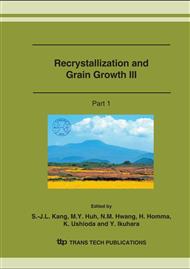p.1183
p.1189
p.1195
p.1201
p.1207
p.1213
p.1219
p.1227
p.1237
Stored Energy and Recrystallisation in Cold Rolled Steel
Abstract:
Plastic deformation induces the dislocation and residual stress fields, which rest in a material after releasing of applied external forces. One can distinguish the stored energy connected with dislocation density and that with residual stresses. The stored energy distributions can be determined experimentally by diffraction experiments and also can be predicted by deformation models. The so obtained distributions of the stored energy versus crystal orientation were correlated with deformation and recrystallization textures of low carbon steel.
Info:
Periodical:
Pages:
1207-1212
Citation:
Online since:
October 2007
Price:
Сopyright:
© 2007 Trans Tech Publications Ltd. All Rights Reserved
Share:
Citation:


